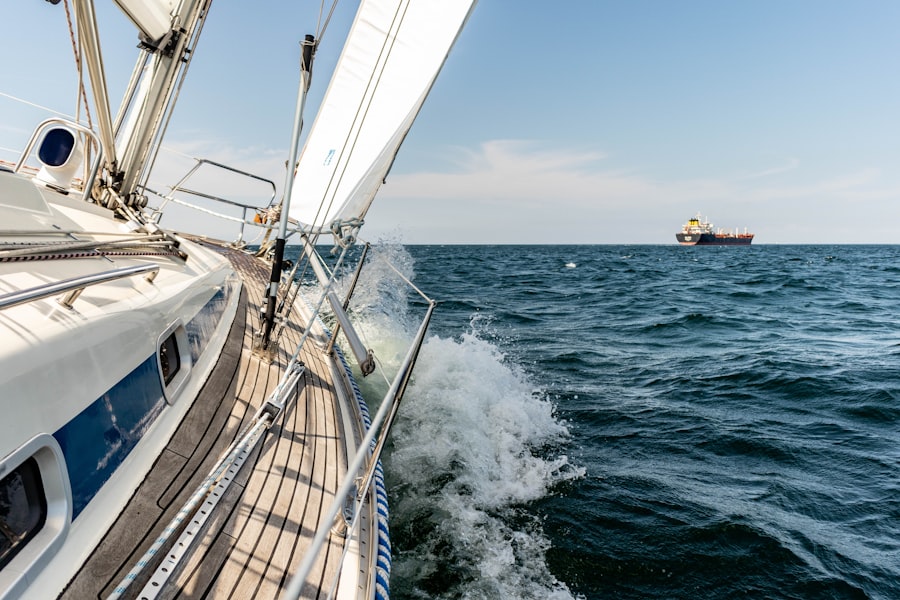Sailing is an intricate blend of art and science, requiring a solid grasp of fundamental principles to navigate the waters effectively. At its core, sailing involves harnessing the wind’s energy to propel a vessel across the water. The primary components of a sailboat include the hull, sails, rigging, and keel.
The hull is the body of the boat, designed to float and provide stability. Sails are fabric structures that catch the wind, while rigging refers to the system of ropes and cables that support and control the sails. The keel, often submerged, provides lateral resistance to prevent the boat from drifting sideways.
Understanding how these components work together is essential for any sailor. The interaction between wind and sail creates lift, similar to how an airplane wing operates. When wind flows over the sail, it generates a difference in pressure on either side, allowing the boat to move forward.
Sailors must also be familiar with various points of sail, which describe the angle of the boat relative to the wind direction. These points include close-hauled, beam reach, broad reach, and running. Each point requires different sail configurations and techniques to maximize speed and efficiency.
Key Takeaways
- Master fundamental sailing concepts to build a strong foundation.
- Learn to read and respond to wind and weather for safe navigation.
- Optimize sail trim and rigging for improved boat performance.
- Practice maneuvering and tacking to handle various sailing situations.
- Prioritize safety protocols and emergency preparedness on board.
Navigating Wind and Weather Conditions
Wind is the lifeblood of sailing, and understanding its behavior is crucial for successful navigation. Wind direction and speed can vary significantly based on geographic location, time of year, and local weather patterns. Sailors must learn to read wind indicators such as flags, ripples on the water’s surface, and even the behavior of other boats.
For instance, a sudden shift in wind direction may signal an approaching storm or a change in weather conditions. Weather conditions also play a pivotal role in sailing. Knowledge of meteorological patterns can help sailors anticipate changes that may affect their journey.
For example, understanding how high-pressure systems bring stable weather while low-pressure systems often lead to storms can inform decision-making on when to set sail or seek shelter. Additionally, sailors should be aware of local phenomena such as sea breezes or squalls that can arise unexpectedly. Utilizing tools like barometers and weather apps can enhance a sailor’s ability to make informed choices based on real-time data.
Perfecting Sail Trim and Rigging

Sail trim is a critical aspect of sailing that directly influences a boat’s performance. Properly trimmed sails allow for optimal airflow and maximum lift, translating into speed and efficiency on the water. Sailors must adjust their sails based on wind conditions and points of sail.
For instance, when sailing close-hauled, sails should be pulled in tightly to reduce drag and maximize lift. Conversely, when on a broad reach or running, sails may need to be eased out to catch more wind. Rigging plays an equally important role in sail performance.
The rigging system must be correctly set up and maintained to ensure that sails can be adjusted easily and effectively. This includes checking halyards, sheets, and other lines for wear and tear, as well as ensuring that all blocks and pulleys are functioning smoothly. A well-rigged boat allows for quick adjustments in response to changing wind conditions, enabling sailors to maintain optimal sail trim throughout their journey.
Maneuvering and Tacking Techniques
| Technique | Description | Key Metrics | Typical Speed Impact | Recommended Conditions |
|---|---|---|---|---|
| Tacking | Turning the bow of the boat through the wind to change direction. | Angle of turn: 90° to 120° Time to complete: 5-15 seconds |
Temporary speed loss of 10-20% | Upwind sailing, moderate to strong winds |
| Jibing | Turning the stern of the boat through the wind to change direction downwind. | Angle of turn: 120° to 180° Time to complete: 5-10 seconds |
Temporary speed loss of 5-15% | Downwind sailing, moderate winds |
| Heaving To | Stopping the boat by balancing sails and rudder to maintain position. | Drift speed: 0.1-0.5 knots Time to stabilize: 1-3 minutes |
Speed reduced to near zero | Heavy weather, resting, or waiting |
| Close-Hauled Sailing | Sailing as close to the wind as possible while maintaining speed. | Point of sail: 30° to 45° to wind Speed: 70-90% of max boat speed |
Maintains high speed with tight angle | Upwind conditions, racing |
| Reaching | Sailing with the wind coming from the side of the boat. | Point of sail: 90° to 135° to wind Speed: 80-100% of max boat speed |
Optimal speed conditions | Beam reach or broad reach conditions |
Maneuvering a sailboat requires skill and precision, particularly when it comes to tacking and gybing—two essential techniques for changing direction. Tacking involves turning the bow of the boat through the wind to change from one tack to another. This maneuver requires careful coordination between the helmsperson and crew members handling the sails.
As the boat approaches the wind, the sails must be released slightly before being pulled in on the new tack to maintain momentum. Gybe maneuvers are executed when changing direction with the wind coming from behind. This technique can be more challenging due to the potential for sudden shifts in wind pressure as the sails cross over from one side of the boat to the other.
Proper timing is crucial; if executed too slowly or too quickly, it can lead to an uncontrolled jibe that may cause damage or injury. Sailors must communicate effectively during these maneuvers, ensuring that everyone is aware of their roles and responsibilities.
Safety and Emergency Procedures
Safety is paramount in sailing, as conditions can change rapidly on the water. Sailors should always be prepared for emergencies by having a comprehensive safety plan in place. This includes wearing life jackets at all times, especially when sailing in rough conditions or with inexperienced crew members.
Additionally, having a well-stocked first aid kit onboard is essential for addressing minor injuries or medical emergencies. In case of severe weather or equipment failure, sailors should know how to execute emergency procedures effectively. This includes understanding how to use flares for signaling distress, deploying life rafts if necessary, and knowing how to communicate with rescue services via VHF radio.
Regular safety drills can help ensure that all crew members are familiar with emergency protocols and can act swiftly in critical situations.
Advanced Navigation and Chart Reading

As sailors gain experience, they often delve into advanced navigation techniques that go beyond basic compass use. Understanding nautical charts is fundamental for safe navigation at sea. These charts provide detailed information about water depths, hazards, currents, and navigational aids such as buoys and lighthouses.
Sailors must learn how to interpret symbols and markings on charts accurately to plot their courses effectively. In addition to traditional chart reading, modern technology has revolutionized navigation with tools like GPS and electronic charting systems (ECS). While these tools enhance accuracy and ease of navigation, sailors should not become overly reliant on them.
Familiarity with celestial navigation techniques—using stars and celestial bodies for positioning—can serve as a valuable backup in case electronic systems fail or become unreliable.
Racing Strategies and Tactics
For those drawn to competitive sailing, understanding racing strategies is essential for success on the racecourse. Sailboat racing involves not only speed but also tactical decision-making based on wind shifts, current conditions, and competitors’ positions. One key strategy is starting well; a good start can set the tone for the entire race.
Sailors must gauge their position relative to the starting line and other boats while considering wind direction to time their start perfectly. Tactics during the race involve making real-time decisions about course adjustments based on changing conditions. For example, sailors may choose to take advantage of shifts in wind direction by altering their course or tacking strategically to gain an edge over competitors.
Additionally, understanding how to position oneself relative to other boats—whether by blocking competitors or finding clear air—can significantly impact race outcomes.
Maintaining and Caring for Your Boat
Proper maintenance is crucial for ensuring a sailboat’s longevity and performance. Regular inspections of key components such as sails, rigging, hull integrity, and engine systems are essential for identifying potential issues before they escalate into major problems. Sailors should develop a maintenance schedule that includes cleaning the hull to prevent growth of marine organisms, checking for leaks or damage in the hull or deck fittings, and inspecting electrical systems for corrosion or wear.
Caring for sails is equally important; they should be cleaned regularly to remove salt and dirt buildup that can degrade fabric over time. Proper storage techniques—such as rolling rather than folding sails—can help maintain their shape and integrity when not in use. Additionally, winterizing procedures are vital for protecting a boat during off-seasons; this may include draining water systems, covering sails with protective tarps, and ensuring that all equipment is stored securely.
By mastering these aspects of sailing—from understanding basic principles to advanced navigation techniques—sailors can enhance their skills on the water while ensuring safety and enjoyment during their voyages.


